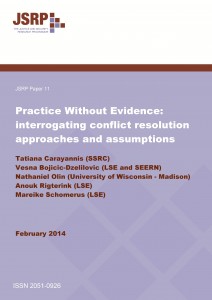By Tatiana Carayannis, Vesna Bojicic-Dzelilovic, Nathaniel Olin, Anouk Rigterink and Mareike Schomerus
 What is the evidence that existing approaches to the resolution of violent conflict have achieved their intended effects to improve the lives of conflict-affected populations? Violent conflict is one of the greatest challenges to development. Two decades of concentrated interventions to mediate, end, or transform violent conflict have generated heated debates and produced a burgeoning field of new scholarship as well as new tools on conflict resolution. Yet, communities worldwide continue to experience conflict every day. It is often unclear whether they experience attempts to resolve violent conflict as successful, or as improving their lives.
What is the evidence that existing approaches to the resolution of violent conflict have achieved their intended effects to improve the lives of conflict-affected populations? Violent conflict is one of the greatest challenges to development. Two decades of concentrated interventions to mediate, end, or transform violent conflict have generated heated debates and produced a burgeoning field of new scholarship as well as new tools on conflict resolution. Yet, communities worldwide continue to experience conflict every day. It is often unclear whether they experience attempts to resolve violent conflict as successful, or as improving their lives.
Our new JSRP Paper, ‘Practice Without Evidence: interrogating conflict resolution approaches and assumptions’, seeks to highlight the experiences of people at the receiving end of practices of conflict resolution, especially international activities. It reviews the evidence base that undergirds contemporary approaches to the resolution of violent conflict in an effort to improve the lives of conflict-affected populations. Through a systematic literature review, the paper explores academic work as well as grey literature that focus on the experiences of the ‘end-users’ of conflict resolution efforts.
Two overarching themes emerge from the literature surveyed. The first is the overwhelming yet under-addressed need to manage conflict complexity, including trans-national dynamics and the proliferation of non-state actors in conflict. The second theme is the omnipresence of normative concepts of conflict resolution, which describe how conflict resolution ought to work based on the liberal principles underpinning it, rather than the actual impact it has.
Despite notable advances that academic literature has made in certain areas of the conflict resolution field, the empirical knowledge base supporting the scholarship has overall been insufficiently robust. In particular, based on the findings from the literature reviewed, there is a need to pursue further research into, and strengthen the evidence base of three inter-related topics which are under-theorised, poorly-understood, or both. Namely: the changing nature of conflict and its diverse origins and manifestations; the conflict networks that emerge and develop through bargaining in the political marketplace; the resulting (and often hybrid) governance and authority structures.
Key findings:
Conceptualisations of governance
Contemporary conflict resolution frameworks revolve around the triangulation of governance, democracy and market-building as a way to stabilise conflict-affected societies. Most of the works on conflict resolution we surveyed do not interrogate what seem to be pre-defined notions of key governance and post-conflict reconstruction ‘outputs’ – for example, security, political stability, economic recovery, and more generally ‘good governance’ and the implied benchmarks for achieving these outputs (Luckham and Kirk 2012). Everyday concerns and priorities of diverse local populations seem to be largely absent from these notions. Similar observations apply to other key concepts within post-war reconstruction frameworks, such as civil society and justice (which are discussed further in the next sections). In fact, the meaning of such concepts is plausibly shaped by the idiosyncrasies of local context.
Hybrid governance and local dynamics
A prominent normative argument in discussions about post-conflict governance is that local structures need to be taken seriously and that a deeper understanding of them is needed (Baker and Scheye 2009; Branch and Mampilly 2005). States are generally seen as playing an uncertain role in this debate. This is largely driven by the idea that while decentralising state authority comes with its own challenges, a locally-owned hybrid minimal state might be an effective and accountable alternative in a post-conflict setting to the long-term statebuilding approach championed by many international interventions (Baker and Sheye 2009).
However, the emphasis on ‘bottom-up’ as a concept and form of intervention is normatively charged. Much of the literature reviewed tends to treat a bottom-up approach as a way to depart from the national and extra-national politics of the conflict by foregrounding local, indigenous, grass roots levels of action and agency. The political element that comes with this shift is largely overlooked, along with the fact that in a ‘post-conflict’ context, actors may well understand ‘bottom-up’ approaches differently, just as they understand ‘community-level’ or ‘local-level interventions’ to mean different things.
Criminality and war economies
Criminality remains a side-subject in conflict resolution, where it is mainly dealt with in terms of outright war criminality, for example, as crimes against humanity, or criminality as a by-product of war, such as looting, theft, and various forms of smuggling. Among a handful of papers on the subject we identified through the systematic literature searches, Andreas (2004) shows how criminality, rather than a by-product of war, is an integral and instrumental aspect of war activity and its transnationalisation.
Role and legitimacy of international actors
A common theme across papers evaluating international interventions is the failure of international actors to appreciate, consider, or conform to the local dynamics in which conflicts and peace processes are situated (Auteserre 2009). This includes divergent or incompatible understandings of political systems, incompatible sociologies between mediators and parties to peace negotiations, or simply a failure on the part of the international community to understand what motivates actors on the ground.
Role and legitimacy of civil society
Engaging civil society is presented as a way to ensure a ‘bottom-up’ process of conflict resolution by articulating end-users’ voices in order to hold the state to account for its actions and to prevent the abuses of power. However, the literature reviewed does not question the many implicit assumptions of this strategy: that civil society organisations do, in fact, represent the interests of all conflict-affected communities rather than particular constituencies within them; or that it is impervious to the politics that drive other national actors; or that including civil society organisations in peace processes is beneficial for both the peace process and its outcome. The papers that do base their results on concrete evidence raise serious cause for concern, as they highlight the political context within which civil society organisations operate and the potential that their inclusion will actually damage the peace process (Van Leeuwen 2008, 2010).
Grassroots participation
The literature reviewed occasionally makes a proposition that grassroots participatory democracy is a possible corrective to the limitations of top-down conflict resolution approaches. However, the findings on how this impacts peacebuilding outcomes are inconclusive, and the reviewed literature captures this ambiguity. Much work focuses on local ‘ownership’ of the conflict resolution process, a slippery and ill-defined term used by peacebuilding researchers and practitioners that has recently come under scrutiny (Donais 2012). International interventions often assume a shared understanding of the aims of the post-war reconstruction process between international actors and the local population. However, there is surprisingly little evidence demonstrating how end-users perceive the goal of post-war reconstruction, the benchmarks of success, or the roles of various actors, including their own.
Participation of women
There seems to be a broad consensus that women’s participation is essential in conflict resolution processes, but the underlying assumptions of this consensus are rarely questioned. Conceptualisations of conflict resolution are gendered and often reductionist in their approach to women’s role in peace processes. Inclusion is often presented as a default feminine operating mode. The benefit of women’s participation in peace processes (beyond a normative conviction that female participation ought to be supported) tends to be based on female ‘soft skills’, such as trust- and community-building (Taylor 2006). Values, rather than empirical data, underscore affirmations of what the role of women ought to be, rather than what it is.
Reintegration of conflict actors
Reintegration of conflict actors is considered a crucial element of conflict resolution. Yet, as is the case with ‘bottom-up processes’, the exact meaning of ‘reintegration’ remains unclear. Reintegration of child soldiers, forced recruits, officially demobilised soldiers, and returnees, as well as rehabilitation of perpetrators, tend to be lumped together under this catch-all term. Furthermore, reintegration can mean anything from returning to one’s home village (part of demobilisation) to entering training programmes to being reinstated as a citizen (see Theidon 2007). Reintegration describes both an informal process of shifting location and reconnecting with family as well as ‘formal’ measures of reintegration, often accompanied by some sort of material support (Archibald and Richards 2002). Furthermore, reintegration covers both the official measures as well as the experience of ‘being reintegrated’.
Justice as an all-encompassing tool
In this literature mapping, justice seems to be readily equated with a measure for peacebuilding, with some critical voices doubting its viability as a reconstructive tool. Evidence that justice does, in fact, build peace in the long run is not presented. It is striking that the literature fails to look at either concept in more detail to allow greater operational insight.
Equating justice and reconciliation
Research on the long-term peacebuilding effect of criminal trials for local communities is unsurprisingly scarce. The question of whether criminal trials specifically support reconciliation – or whether indeed this should be the courts’ mandate – is barely addressed. Truth-telling remains a buzzword in conflict resolution studies and is often seen as the ultimate tool to facilitate true reconciliation. However, the problem remains of establishing integrated conflict narratives, rather than establishing what might be perceived as biased or partial truths, including the issue of whether a facilitator can ever be perceived as unbiased (Lundy and McGovern 2006).
Note: This article gives the views of the authors, and not the position of the Justice and Security Research Programme, nor of the London School of Economics.




